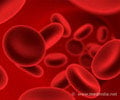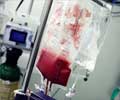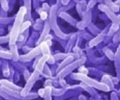In O blood group persons, cholera toxin induces high levels of a signaling molecule in intestinal cells, causing a more severe degree of diarrhea and dehydration.
- Cholera affects 3 million to 5 million people globally every year, leading to over 100,000 deaths.
- Severity of cholera infection and related deaths is more in persons with blood group O.
- Diarrhea and dehydration in cholera are mediated via a signaling molecule in the intestinal cells.
- Cholera toxin causes excessive levels of this molecule in O blood group persons, leading to more severe disease.
Lead up To The Study
For long it has been known that blood group O persons suffer from severe cholera, more likely to be hospitalized and sadly more likely to die from the disease too. Though Public Health specialists (epidemiologists) first made this observation nearly four decades ago, the reasons for that have remained a mystery. Scientists at the Washington University School of Medicine in St. Louis, led by James Fleckenstein, MD, an associate professor of medicine and molecular microbiology, attempt in this study to explain why.Intestinal Epithelial Stem Cells – The Target Cells of This Study
Although the blood group antigens – A, B, AB and O – are mainly present on the surface of red blood cells, they also occur on the surface of many other cell types, including the lining cells of the intestine.
To determine the effect of cholera toxin on intestinal cells carrying different blood group antigens, Fleckenstein, F. Matthew Kuhlmann, MD, Matthew Ciorba, MD, and colleagues used clusters of intestinal epithelial stem cells, called enteroids, that could be cultivated in the lab and are capable of differentiating into mature intestinal epithelial cells.
Washington University is one of the leading centers to have built a bio bank of intestinal epithelial stem cells (enteroids), derived from patients for the purpose of research. Since these clusters of stem cells are derived from normal intestinal cells from several individuals, they are better than traditional cell lines, which are derived from cancer cells from a single person and may contain mutations that cause them to behave differently compared to normal cells.
Details of The Study
They found that levels of the signaling molecule were roughly twice as high in the cells with the ‘O’ antigen than in the cells with the ‘A’ antigen, suggesting that people with group O antigen who were exposed to cholera toxin would probably suffer more severe diarrhea and dehydration.
“It is well-established that high levels of this molecule lead to diarrhea, so we’re making the assumption that higher levels lead to even more diarrhea,” said Kuhlmann, an instructor in medicine and the lead author on the study. “Unfortunately, we have no way directly to link the responses to the volume of diarrhea and, therefore, the severity of disease.”
Validation of The Results
The scientists re-confirmed their original results in an intestinal cell line originally derived from a person with blood group A. The cell line was modified to produce the ‘O’ antigen instead.
They found that cholera toxin induced almost double the amount of the key signaling molecule in cells with O antigen than in the intestinal cells with A antigen.
Fleckenstein isn’t sure why intestinal cells with different blood group antigens on their surface respond differently to the cholera toxin.
“The cholera toxin is known to bind weakly to the ABO antigens, so they may be acting as decoys to draw the toxin away from its true target,” Fleckenstein said. “It may be that the type O antigen just isn’t as good of a decoy as the type A antigen.”
About Cholera
It is a bacterial infection caused by Vibrio cholerae, affecting the small intestine. The organism releases a toxin, the cholera toxin, that causes infected intestinal cells to secrete huge quantities of water and salt into the intestinal lumen, leading to severe diarrhea and dehydration that may result in shock, and even death in severe cases.
Prompt fluid and electrolyte replacement, and control of infection are critical to management.
Epidemiology of Cholera
It is transmitted via the fecal-oral route by ingestion of contaminated food or water.
Cholera affects between 3 to 5 million people around the world annually, leading to 100,000 to 120,000 deaths. The disease has been endemic in the Indian subcontinent for centuries, and also sees the most number of cholera related deaths.
A cholera epidemic has persisted in Haiti since 2010, brought by United Nations (UN) workers from Nepal. These workers had come to Haiti as part of the UN team to help rebuild the country following a massive earthquake earlier.
Interesting Observations From The Study
In the Ganges River delta region of India and Bangladesh, where cholera is highly endemic, blood group O is less common than in the rest of the world. Only 37 percent of Indians and 33 percent of Bangladeshis have blood group O, as compared to 45 percent of people around the world, according to published research. It is believed that the deadliness of the disease made having the type O antigen a liability, causing nature to reduce the proportion of type O people in endemic regions.
The study also shows that enteroids, or clusters of intestinal stem cells that were developed only recently, could be an important tool for studying infectious diseases of the gut.
“The beautiful thing about this research is that we’ve taken intestinal cells from people here in Missouri and used them to understand the pathophysiology of a disease that affects people worldwide,” said Ciorba, an assistant professor of medicine and one of the study’s authors.
“In this particular situation, we knew that the epidemiologists thought that blood type mattered, but using enteroids, we’re actually able to see those differences in different people. It’s a proof of principle that this system can answer questions of global impact.”
Cholera Prevention
From the long term point of view, a safe water supply, better sanitation, food safety and creating community awareness are the best means to control cholera and other diarrhoeal illnesses.
However, WHO is also studying the use of latest tools to complement these traditional measures. Oral cholera vaccines proven to be safe and effective have recently become available for commercial use. Some countries have already tried using oral cholera vaccines to immunize populations considered to be at high risk for cholera epidemics.
At present, two oral cholera vaccines are available, namely Dukoral ( made by SBL Vaccines) and ShanChol (made by Shantha Biotec in India), which are World Health Organization (WHO) prequalified.
Since the vaccines are two-dose vaccines, many weeks can elapse before people getting vaccinated are protected. Vaccines give only incomplete protection. Therefore, vaccination should not replace standard prevention and control measures.
Evidence gained following the use of oral cholera vaccines is now available for analysis. Work is in progress to determine the role of mass vaccination as a public health strategy to protect at risk populations against cholera.
References:
- Study may explain why some people with type O blood more likely to die of cholera - (https://medicine.wustl.edu/news/study-may-explain-people-type-o-blood-likely-die-cholera/)
- Information on Cholera - (https://en.wikipedia.org/wiki/Cholera#Epidemiology)
- Cholera Vaccines - (http://www.who.int/topics/cholera/vaccines/en/)















